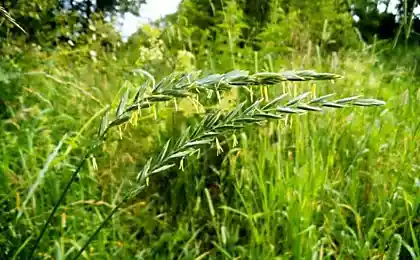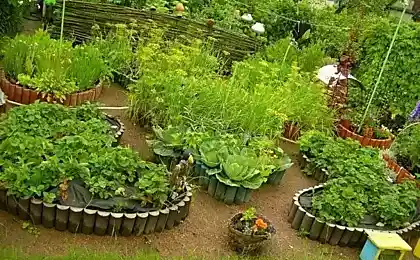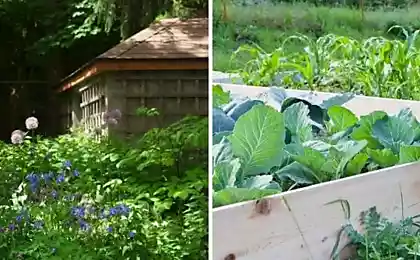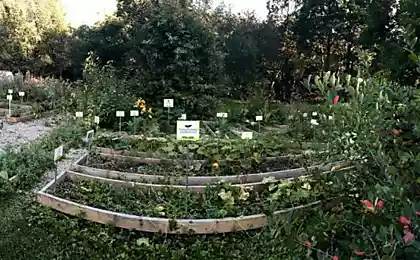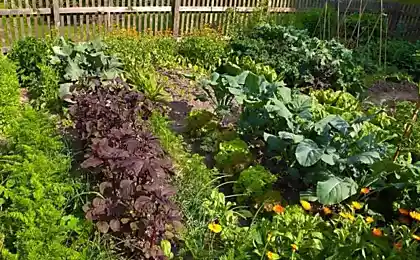196
An experienced summer resident said that you need to plant in the garden so that the bear bypassed him
With age, views of life change and many things are perceived completely differently. As a child, for example, our old cottage by the pond with a neat garden and a small garden seemed to me a paradise, where plenty of fresh vegetables, fruits and berries. Now it is associated not so much with rest in the fresh air, as with the eternal struggle for their own harvest with resourceful pests. They are resourceful not because they are savvy, but because they find everything tasty on the site and strive to eat. An extremely insidious devourer among insects is an ordinary bear. I had to get to know her better.
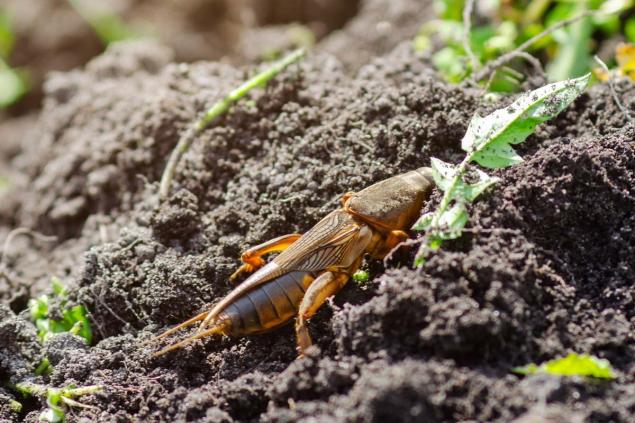
Today's edition. "Site" I will tell you more about this insect and how to deal with it.
The bear is an ordinary Cape, top, mole cricket, earthen cancer - such folk names are an ordinary bear. But, whatever you call her, and the disposition of an unpleasant-looking creature does not change. This creature is omnivorous and chews everything that comes in the way. It feeds on seeds, tubers, bulbs, roots, shoots and stems, and eats small spineless ones. That is, the insect will not die of hunger.
An ordinary bear prefers wet areas of the garden, well fertilized with manure. It digs passages in the soil, damaging the delicate roots of young plants. The female beetle builds a nest at a depth of 20 cm and lays eggs in an amount of at least 300 pieces. Due to the incredible fertility, the pest spreads quite quickly. If you do not take measures to combat it, you can be left without a harvest.
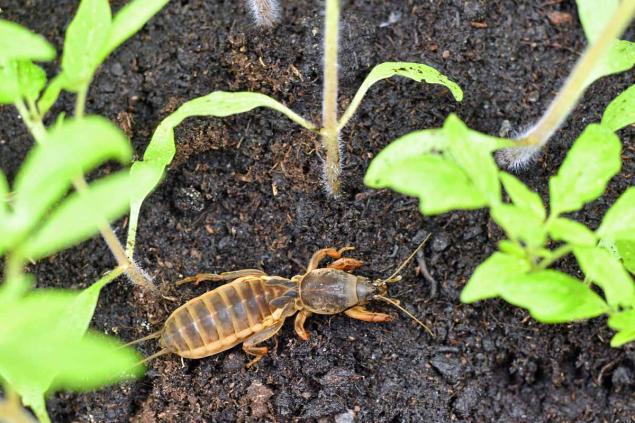
What is a bear afraid of and how to deal with it? Wolves die at low temperatures. In the garden at a depth of 80 cm, traps are prepared for them: after harvesting, they dig a hole, fill it with manure and sprinkle it with earth from above, sticking a branch to indicate the place. It is recommended to use horse dung for trapping, because beetles like it the most. Insects will gather here for the winter. In the middle of winter, the trap is excavated and dung is scattered in a thin layer around the bed. The pests hidden in it will freeze every single one.
In spring and summer, during digging or weeding beds, summer residents are advised to pour 100 ml of unrefined sunflower oil or 1 liter of homemade solution into burrows, which is prepared by mixing water with diesel fuel, chicken droppings, household soap or other detergent. Instead of a solution, you can take an infusion of celandine. For its preparation, it is required to pour half a bucket of crushed plants to the top with water, let it brew for 3 days and strain. Getting to the surface of beetles must be collected and destroyed.
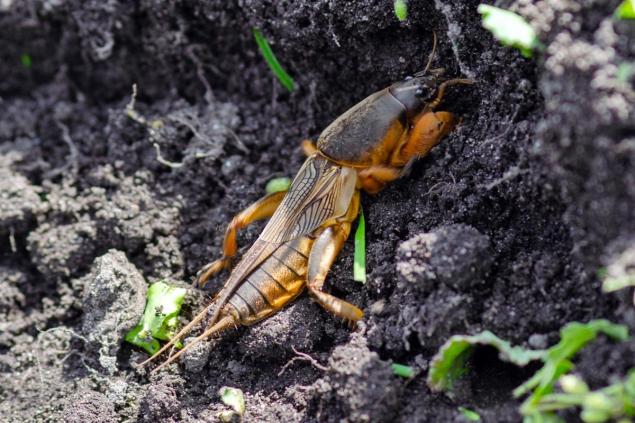
Chicken droppings should be collected. It is used to fertilize the soil, and also scattered in the garden to scare away pests. Eggshells are used for the same purpose. It must be crushed and poured into each hole or groove when it is necessary to ward off earthen cancer. If the garden is small, then you can spray the crumb throughout the area.
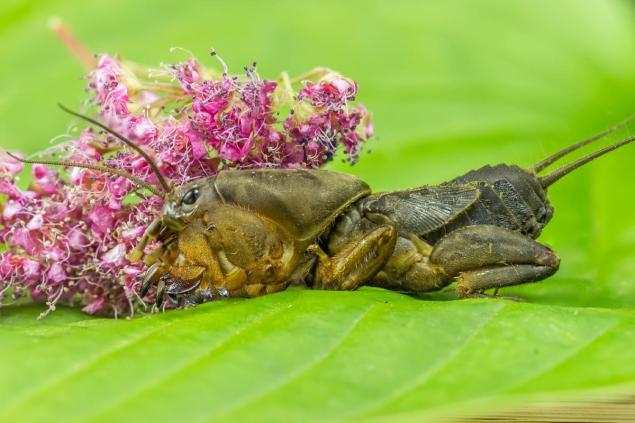
Traps and traps To exterminate bears put special traps and tunnel traps. They are bought in the store or made independently. The most primitive trap is a bottle filled with a quarter of beer. It is buried in the ground at a sharp angle. The neck should remain a recess, which must be well moistened. The structure is hidden from the sun under a piece of tin, linoleum or slate.
Check the catch every three days. Some craftsmen manage to catch cricket moles on triple fishing hooks, which are used when angling predatory fish. Tees are tied with a fishing line to a stick, leaving a small leash, and lowered into a burrow. The resulting copies are pulled out.

Insecticides are used to kill tops. Feeding insect poison is very simple. You need to boil peas, wheat, corn or barley in an old pan and cool it. Seeds can not be subjected to heat treatment, and pour overnight beer. Then a poisonous drug is added to the container and insist for a day. The etched grain is distributed in pits throughout the plot and covered with pieces of slate or sprinkled with earth so that the birds do not eat it.
On sale there is already processed millet, which can immediately be used in the country. Using chemical means of pest control, it is necessary to follow safety rules and work with gloves.
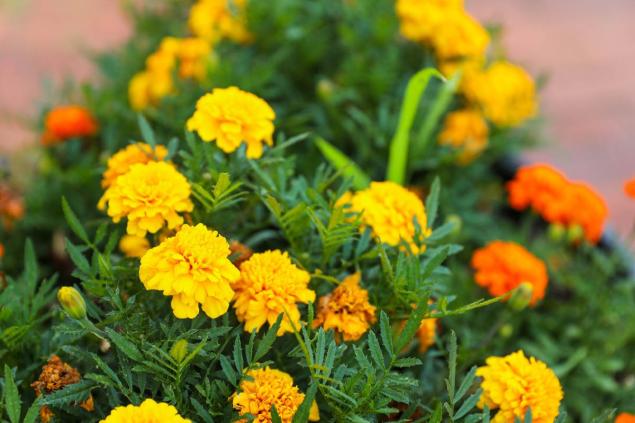
There is an opinion that cabbage does not tolerate the aroma of calendula, velvets and mustard. It is possible that she does not like these plants, but I failed to drive out pests with their help. So I put a beer bottle on the site and buried the poisoned corn. After that, the tops disappeared.
What ways do you know how to deal with a bear? Can you share your experience?

Today's edition. "Site" I will tell you more about this insect and how to deal with it.
The bear is an ordinary Cape, top, mole cricket, earthen cancer - such folk names are an ordinary bear. But, whatever you call her, and the disposition of an unpleasant-looking creature does not change. This creature is omnivorous and chews everything that comes in the way. It feeds on seeds, tubers, bulbs, roots, shoots and stems, and eats small spineless ones. That is, the insect will not die of hunger.
An ordinary bear prefers wet areas of the garden, well fertilized with manure. It digs passages in the soil, damaging the delicate roots of young plants. The female beetle builds a nest at a depth of 20 cm and lays eggs in an amount of at least 300 pieces. Due to the incredible fertility, the pest spreads quite quickly. If you do not take measures to combat it, you can be left without a harvest.

What is a bear afraid of and how to deal with it? Wolves die at low temperatures. In the garden at a depth of 80 cm, traps are prepared for them: after harvesting, they dig a hole, fill it with manure and sprinkle it with earth from above, sticking a branch to indicate the place. It is recommended to use horse dung for trapping, because beetles like it the most. Insects will gather here for the winter. In the middle of winter, the trap is excavated and dung is scattered in a thin layer around the bed. The pests hidden in it will freeze every single one.
In spring and summer, during digging or weeding beds, summer residents are advised to pour 100 ml of unrefined sunflower oil or 1 liter of homemade solution into burrows, which is prepared by mixing water with diesel fuel, chicken droppings, household soap or other detergent. Instead of a solution, you can take an infusion of celandine. For its preparation, it is required to pour half a bucket of crushed plants to the top with water, let it brew for 3 days and strain. Getting to the surface of beetles must be collected and destroyed.

Chicken droppings should be collected. It is used to fertilize the soil, and also scattered in the garden to scare away pests. Eggshells are used for the same purpose. It must be crushed and poured into each hole or groove when it is necessary to ward off earthen cancer. If the garden is small, then you can spray the crumb throughout the area.

Traps and traps To exterminate bears put special traps and tunnel traps. They are bought in the store or made independently. The most primitive trap is a bottle filled with a quarter of beer. It is buried in the ground at a sharp angle. The neck should remain a recess, which must be well moistened. The structure is hidden from the sun under a piece of tin, linoleum or slate.
Check the catch every three days. Some craftsmen manage to catch cricket moles on triple fishing hooks, which are used when angling predatory fish. Tees are tied with a fishing line to a stick, leaving a small leash, and lowered into a burrow. The resulting copies are pulled out.

Insecticides are used to kill tops. Feeding insect poison is very simple. You need to boil peas, wheat, corn or barley in an old pan and cool it. Seeds can not be subjected to heat treatment, and pour overnight beer. Then a poisonous drug is added to the container and insist for a day. The etched grain is distributed in pits throughout the plot and covered with pieces of slate or sprinkled with earth so that the birds do not eat it.
On sale there is already processed millet, which can immediately be used in the country. Using chemical means of pest control, it is necessary to follow safety rules and work with gloves.

There is an opinion that cabbage does not tolerate the aroma of calendula, velvets and mustard. It is possible that she does not like these plants, but I failed to drive out pests with their help. So I put a beer bottle on the site and buried the poisoned corn. After that, the tops disappeared.
What ways do you know how to deal with a bear? Can you share your experience?
Really great movies that can completely change your worldview
What to cook from a gentle and light filo dough to feed the family with a hearty dinner





